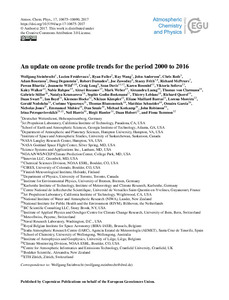Por favor, use este identificador para citar o enlazar este ítem:
http://hdl.handle.net/20.500.11765/6882
An update on ozone profile trends for the period 2000 to 2016
Registro completo de metadatos
| Campo DC | Valor | Lengua/Idioma |
|---|---|---|
| dc.contributor.author | Steinbrecht, Wolfgang | es_ES |
| dc.contributor.author | Froidevaux, Lucien | es_ES |
| dc.contributor.author | Fuller, Ryan | es_ES |
| dc.contributor.author | Wang, Ray | es_ES |
| dc.contributor.author | Anderson, John | es_ES |
| dc.contributor.author | Roth, Chris | es_ES |
| dc.contributor.author | Bourassa, Adam | es_ES |
| dc.contributor.author | Degenstein, Doug | es_ES |
| dc.contributor.author | Damadeo, Robert | es_ES |
| dc.contributor.author | Zawodny, Joe | es_ES |
| dc.contributor.author | Frith, Stacey | es_ES |
| dc.contributor.author | McPeters, Richard | es_ES |
| dc.contributor.author | Bhartia, Pawan K. | es_ES |
| dc.contributor.author | Wild, Jeannette | es_ES |
| dc.contributor.author | Long, Craig | es_ES |
| dc.contributor.author | Davis, Sean | es_ES |
| dc.contributor.author | Rosenlof, Karen | es_ES |
| dc.contributor.author | Sofieva, Viktoria | es_ES |
| dc.contributor.author | Walker, Kaley | es_ES |
| dc.contributor.author | Rahpoe, Nabiz | es_ES |
| dc.contributor.author | Rozanov, Alexei | es_ES |
| dc.contributor.author | Weber, Mark | es_ES |
| dc.contributor.author | Laeng, Alexandra | es_ES |
| dc.contributor.author | Clarmann, Thomas von | es_ES |
| dc.contributor.author | Stiller, Gabriele P. | es_ES |
| dc.contributor.author | Kramarova, Natalya | es_ES |
| dc.contributor.author | Godin-Beekmann, Sophie | es_ES |
| dc.contributor.author | Leblanc, Thierry | es_ES |
| dc.contributor.author | Querel, Richard | es_ES |
| dc.contributor.author | Swart, Daan | es_ES |
| dc.contributor.author | Boyd, Ian | es_ES |
| dc.contributor.author | Hocke, Klemens | es_ES |
| dc.contributor.author | Kämpfer, Niklaus | es_ES |
| dc.contributor.author | Maillard Barras, Eliane | es_ES |
| dc.contributor.author | Moreira, Lorena | es_ES |
| dc.contributor.author | Nedoluha, Gerald | es_ES |
| dc.contributor.author | Vigouroux, Corinne | es_ES |
| dc.contributor.author | Blumenstock, Thomas | es_ES |
| dc.contributor.author | Schneider, Matthias | es_ES |
| dc.contributor.author | García Rodríguez, Omaira Elena | es_ES |
| dc.contributor.author | Jones, Nicholas | es_ES |
| dc.contributor.author | Mahieu, Emmanuel | es_ES |
| dc.contributor.author | Smale, Dan | es_ES |
| dc.contributor.author | Kotkamp, Michael | es_ES |
| dc.contributor.author | Robinson, John | es_ES |
| dc.contributor.author | Petropavlovskikh, Irina | es_ES |
| dc.contributor.author | Harris, Neil R. P. | es_ES |
| dc.contributor.author | Hassler, Birgit | es_ES |
| dc.contributor.author | Hubert, Daan | es_ES |
| dc.contributor.author | Tummon, Fiona | es_ES |
| dc.date.accessioned | 2017-05-10T07:29:28Z | - |
| dc.date.available | 2017-05-10T07:29:28Z | - |
| dc.date.issued | 2017 | - |
| dc.identifier.citation | Atmospheric Chemistry and Physics. 2017, 17(17), p. 10675–10690 | es_ES |
| dc.identifier.issn | 1680-7316 | - |
| dc.identifier.issn | 1680-7324 | - |
| dc.identifier.uri | http://hdl.handle.net/20.500.11765/6882 | - |
| dc.description.abstract | Ozone profile trends over the period 2000 to 2016 from several merged satellite ozone data sets and from ground-based data measured by four techniques at stations of the Network for the Detection of Atmospheric Composition Change indicate significant ozone increases in the upper stratosphere, between 35 and 48 km altitude (5 and 1 hPa). Near 2 hPa (42 km), ozone has been increasing by about 1.5 % per decade in the tropics (20° S to 20° N), and by 2 to 2.5 % per decade in the 35 to 60° latitude bands of both hemispheres. At levels below 35 km (5 hPa), 2000 to 2016 ozone trends are smaller and not statistically significant. The observed trend profiles are consistent with expectations from chemistry climate model simulations. This study confirms positive trends of upper stratospheric ozone already reported, e.g., in the WMO/UNEP Ozone Assessment 2014 or by Harris et al. (2015). Compared to those studies, three to four additional years of observations, updated and improved data sets with reduced drift, and the fact that nearly all individual data sets indicate ozone increase in the upper stratosphere, all give enhanced confidence. Uncertainties have been reduced, for example for the trend near 2 hPa in the 35 to 60° latitude bands from about ±5 % (2σ) in Harris et al. (2015) to less than ±2 % (2σ). Nevertheless, a thorough analysis of possible drifts and differences between various data sources is still required, as is a detailed attribution of the observed increases to declining ozone-depleting substances and to stratospheric cooling. Ongoing quality observations from multiple independent platforms are key for verifying that recovery of the ozone layer continues as expected. | es_ES |
| dc.description.sponsorship | Fiona Tummon was supported by Swiss National Science Foundation grant num-5 ber 20FI21_138017. | es_ES |
| dc.language.iso | eng | es_ES |
| dc.publisher | European Geosciences Union | es_ES |
| dc.rights | Licencia CC: Reconocimiento CC BY | es_ES |
| dc.subject | Ozone profile trends | es_ES |
| dc.subject | Satellite data | es_ES |
| dc.subject | Upper stratosphere | es_ES |
| dc.subject | Ozone depleting chlorine | es_ES |
| dc.title | An update on ozone profile trends for the period 2000 to 2016 | es_ES |
| dc.type | info:eu-repo/semantics/article | es_ES |
| dc.relation.publisherversion | https://doi.org/10.5194/acp-17-10675-2017 | es_ES |
| dc.rights.accessRights | info:eu-repo/semantics/openAccess | es_ES |
| Colecciones: | Artículos científicos 2015-2018 | |
Ficheros en este ítem:
| Fichero | Descripción | Tamaño | Formato | ||
|---|---|---|---|---|---|
| acp-17-10675-2017.pdf | 1,3 MB | Adobe PDF |  Visualizar/Abrir |
Los ítems de Arcimis están protegidos por una Licencia Creative Commons, salvo que se indique lo contrario.





